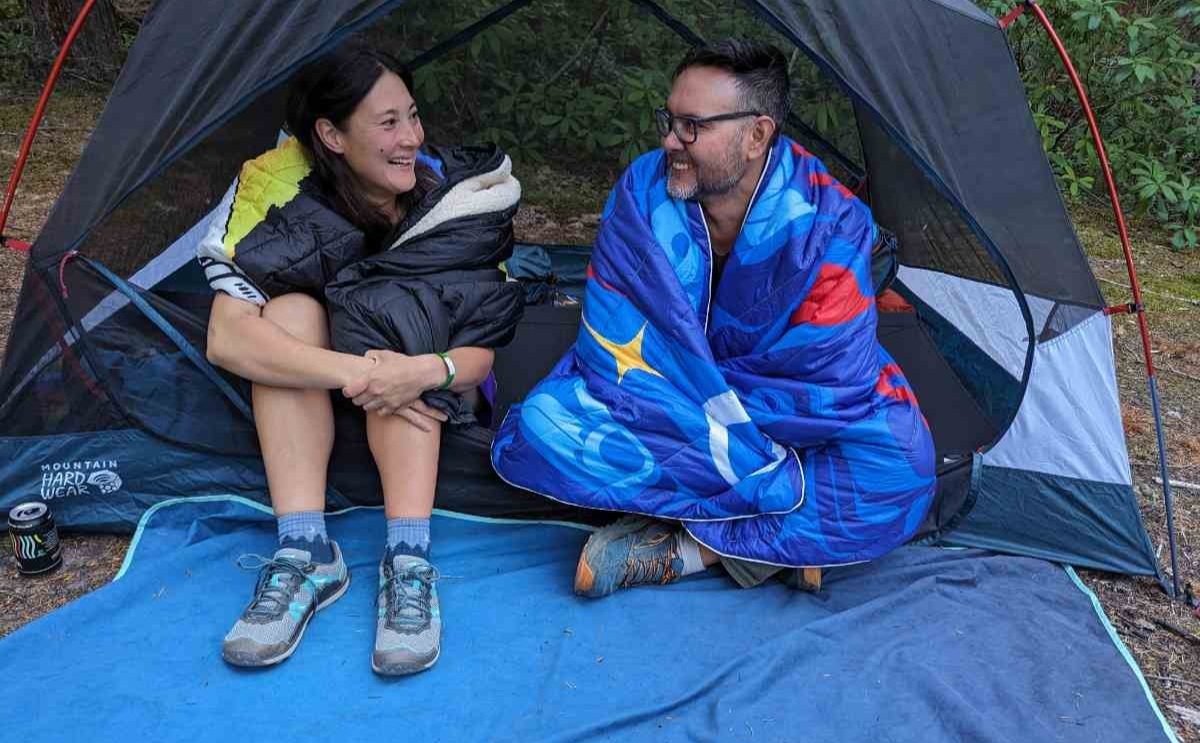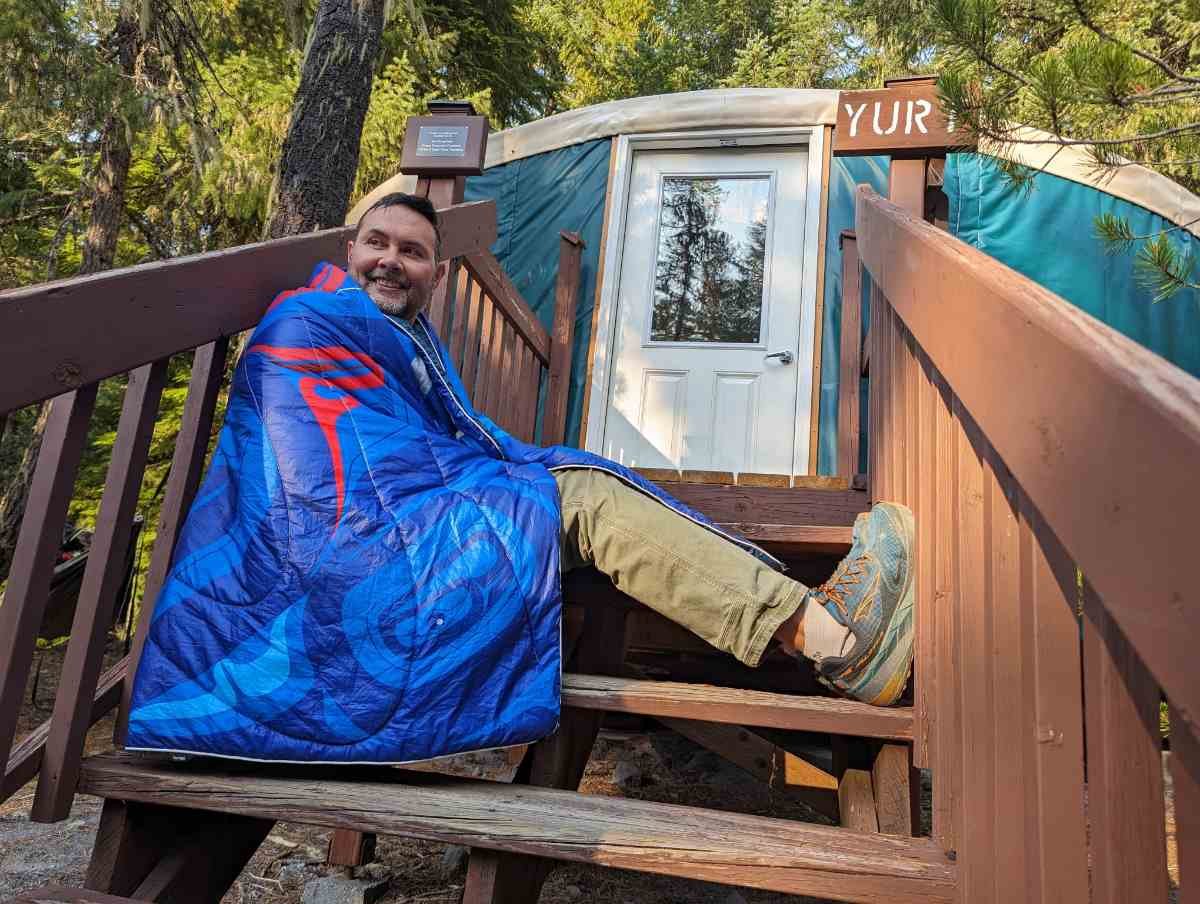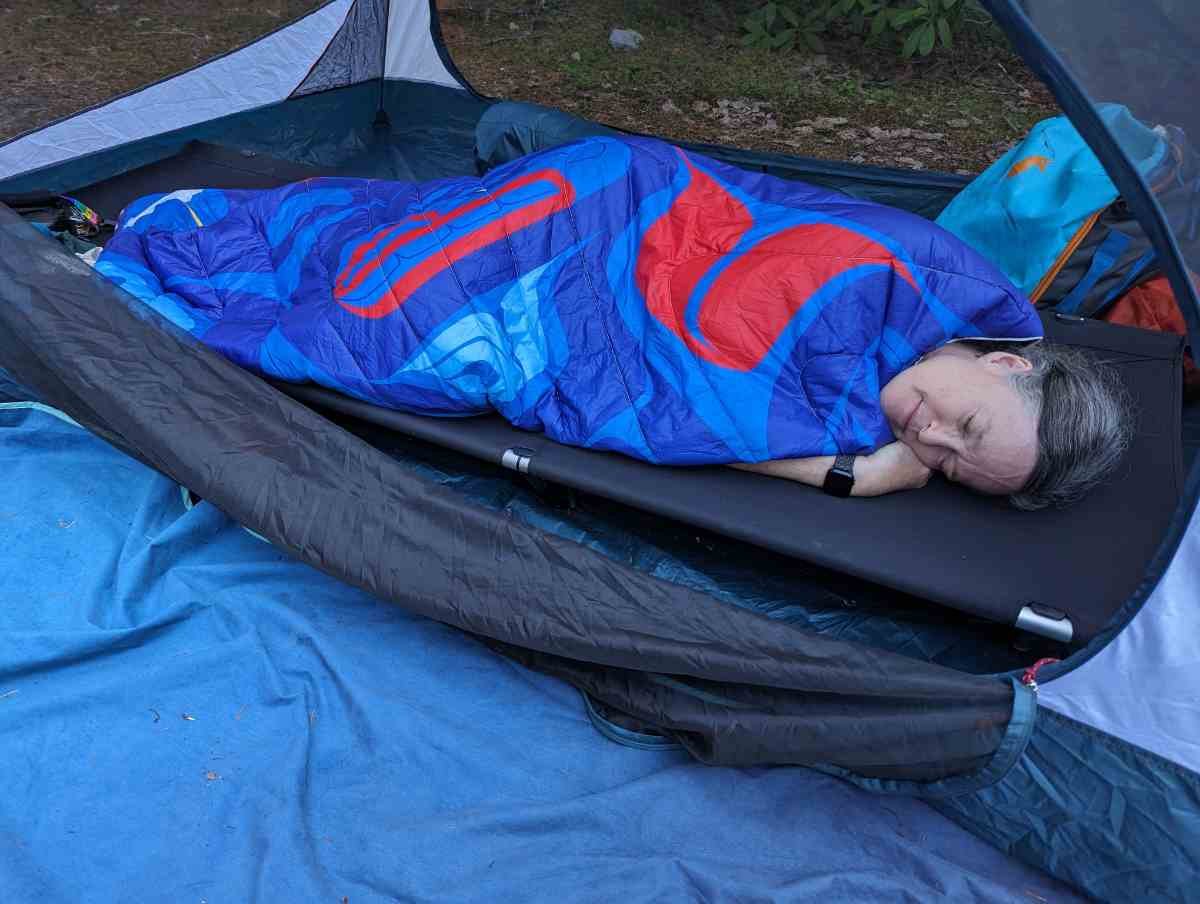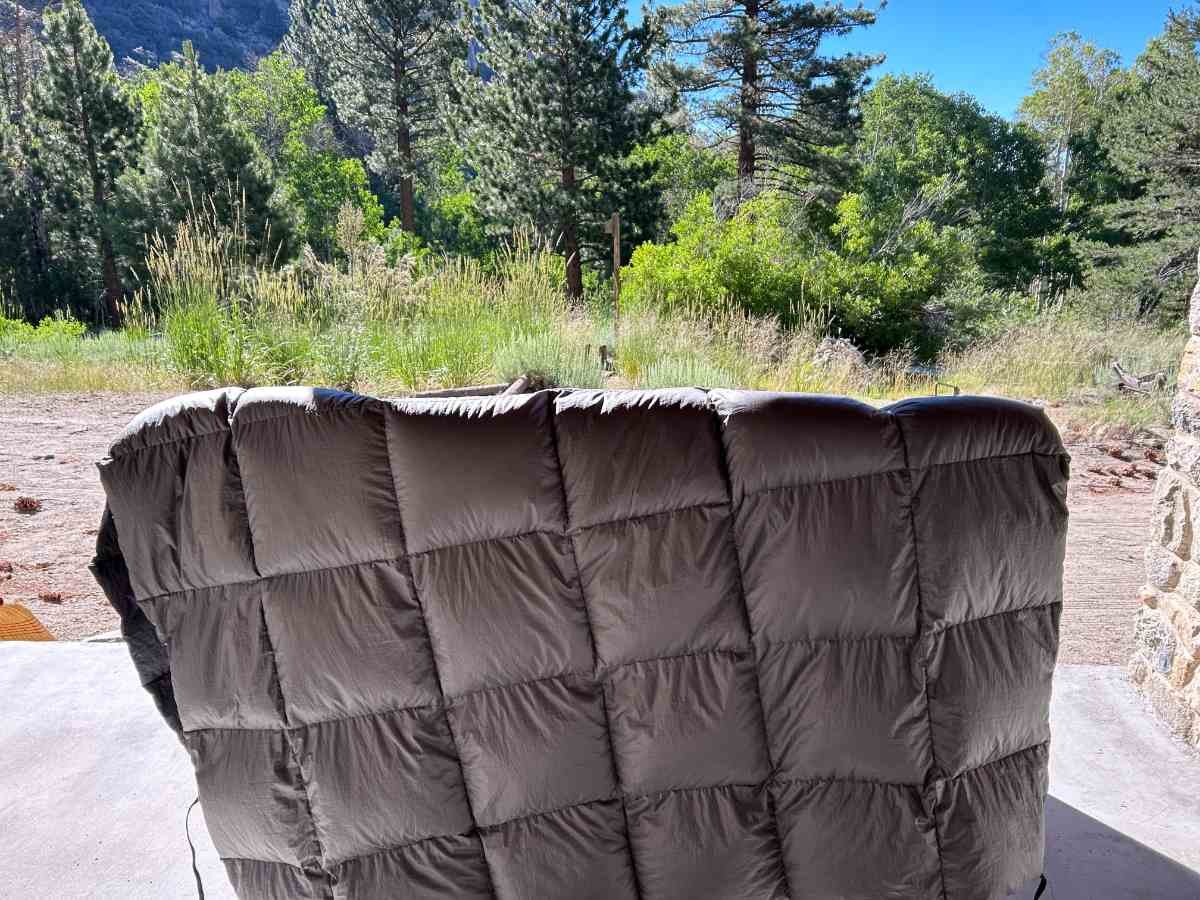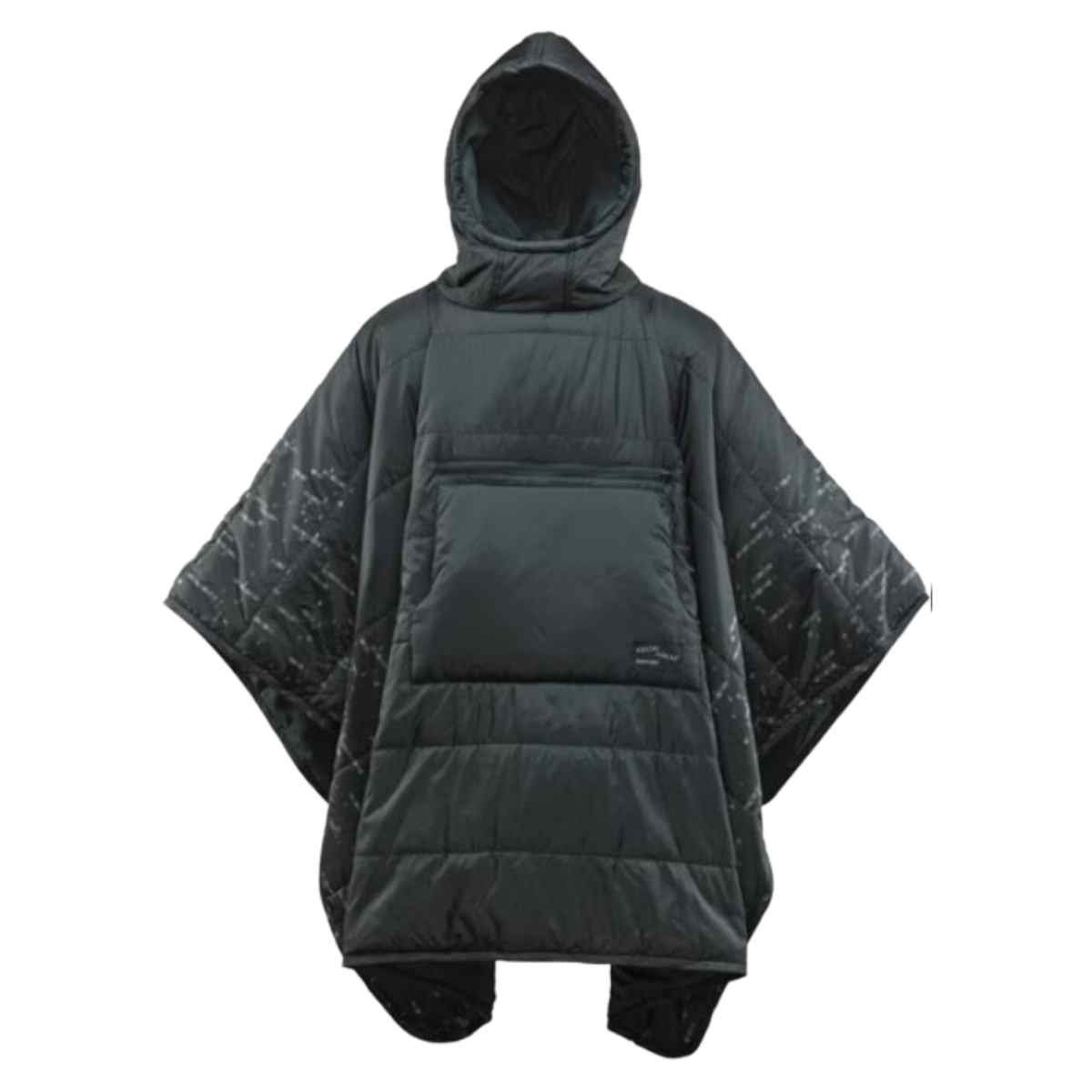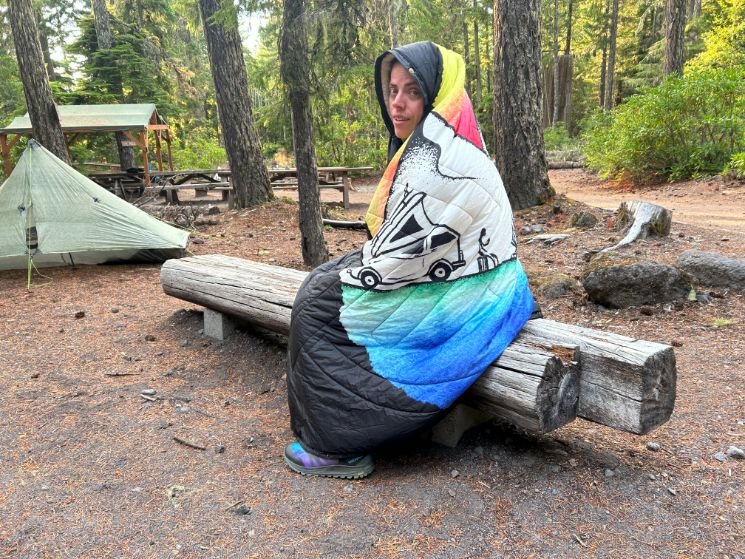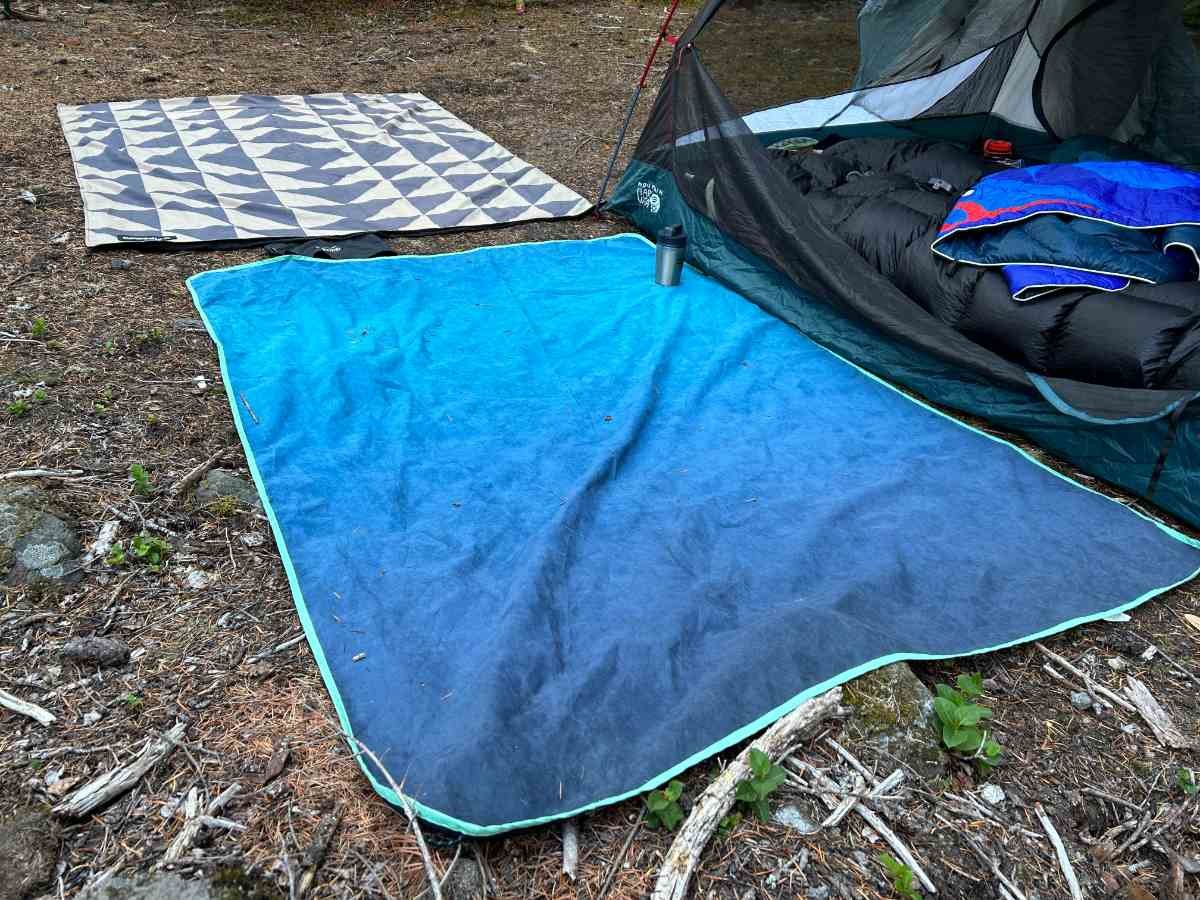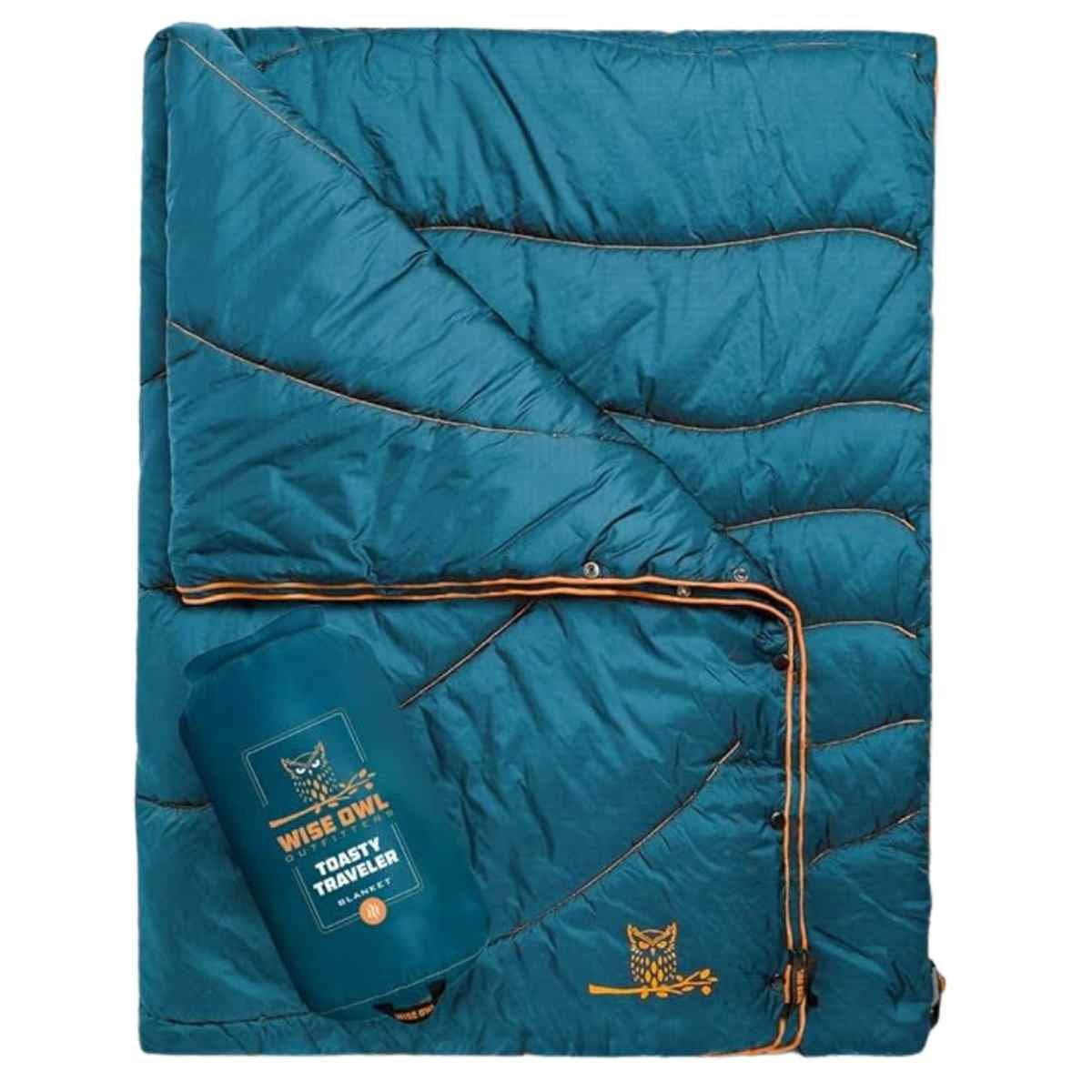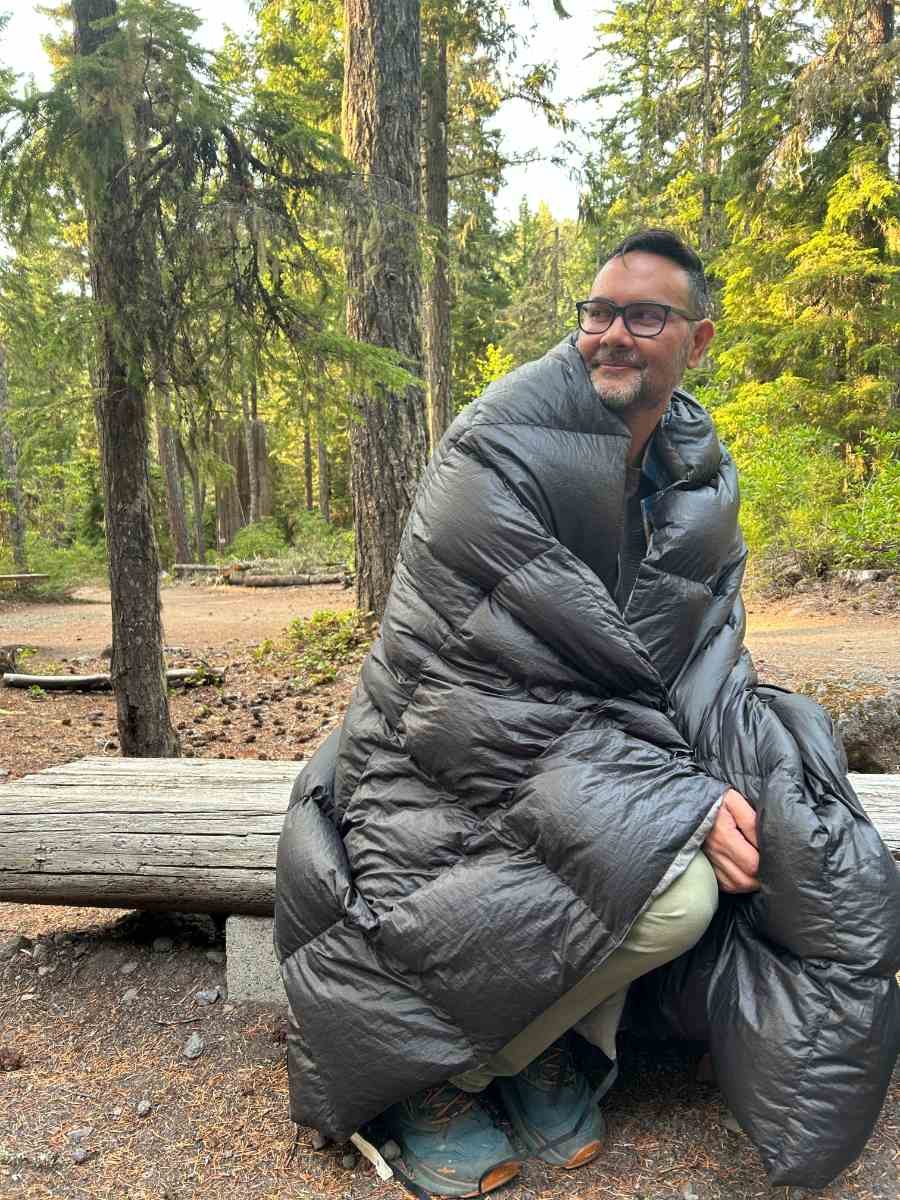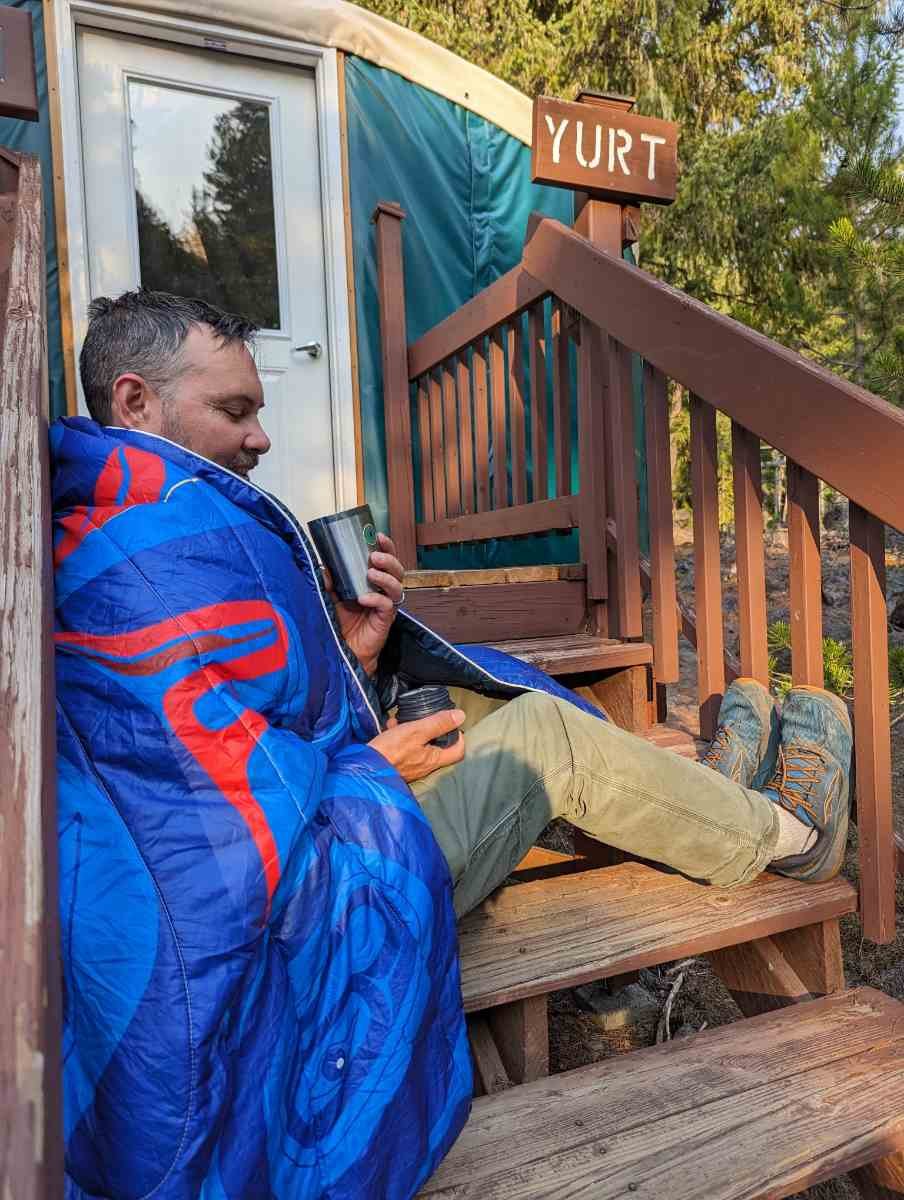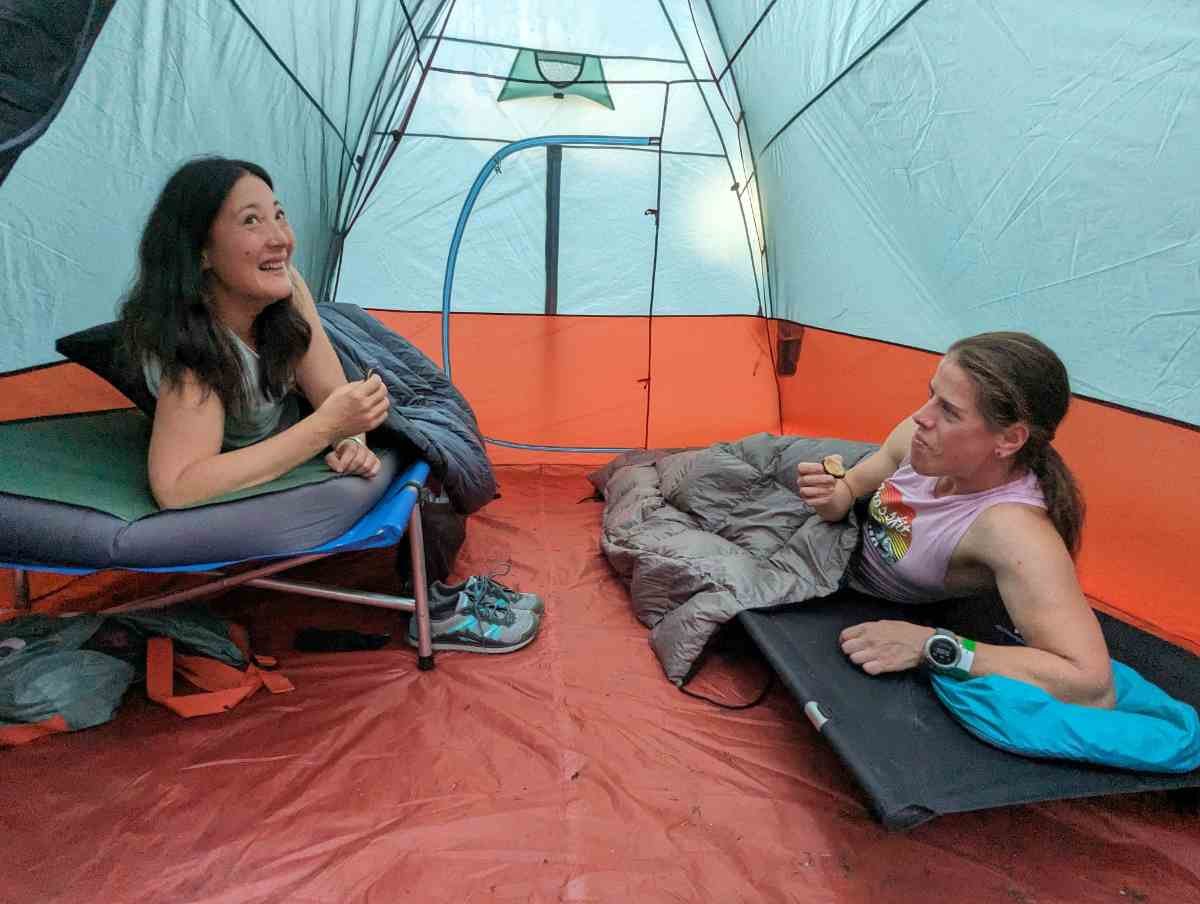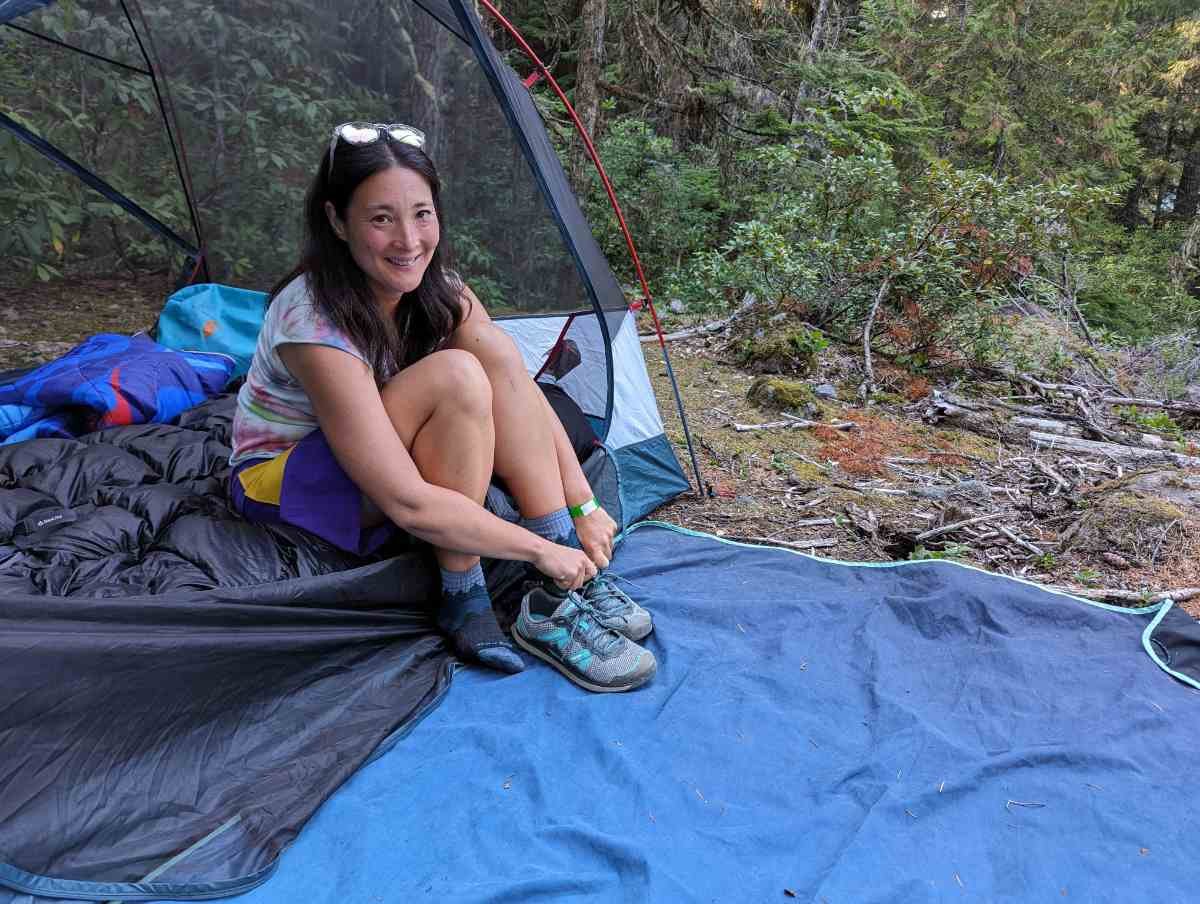Best Outdoor and Camping Blankets of 2025
Puffy Blankets, Picnic Blankets, Waterproof Blankets, And Fleece And Down Blankets For Camping, Travel, Festivals, And Cabins
Home > Gear Reviews > Camping
December 13th, 2024, updated with 3 more models tested and a new winner for best travel
Camping blankets are designed to be significantly more water-resistant, mud-resistant, and easier to clean than typical bedding. Outdoor blankets are more compact and packable than regular blankets, often coming with stuff sacks. Puffy blankets also have more insulation than many home blankets and are multi-use.
To find the best camping blankets, we tested eleven blankets alongside an old bed sheet and fleece blanket (to make sure outdoor blankets truly are better than other alternatives).
We lugged them around with us nearly everywhere for two years, including 35 flights to outdoor destinations around the country. We used our outdoor blankets on fishing trips to Montana, at an environmental camp for a month in the Eastern Sierra, and at outdoor festivals and concerts in Oregon and California.
My puffy blankets come with me on camping trips, to music festivals, to picnics, the beach, and backyard barbecues. I use them to keep bugs off me when sitting on the porch at the cabin. They're also useful to throw in the back of the car when traveling with dogs or after swimming or hiking in the rain or somewhere muddy or sandy.
Outdoor blankets are a gear item I didn't know I needed until I got one. Now that I have camping blankets in my life, I can't imagine my life without them. These are the best camping and outdoor blankets for all kinds of situations.
We create reader-supported, objective gear reviews independently selected by our editors. This story may contain affiliate links, which help fund our website. When you click on the links to purchase gear, we may get a commission — without costing you an extra cent. Thank you for supporting our work and mission of outdoor coverage for every body! Learn more.
Comparison table
| OUTDOOR BLANKET | TREELINE AWARD | BEST USE | MSRP* | MACHINE WASHABLE? | INSULATION | SHELL MATERIAL | WEIGHT | SIZES AVAILABLE |
|---|---|---|---|---|---|---|---|---|
| Rumpl Original Puffy Blanket | Best Overall Read why |
Camping, picnics, festivals | $99, $199 | yes | 100% recycled 3D hollow fiber siliconized synthetic insulation; 240 gsm | 100% recycled 30D ripstop polyester fabric | 9.6 oz / 33.6 oz / 59.2 oz | 28" x 40" (junior) / 75" x 52" (1-person/full) / 84" x 80" (2-person) |
| Nomadix Festival Blanket | Best Picnic Read why |
Picnics, camping, lawn sitting, festivals | $70 | yes | n/a | 88% post-consumer recycled polyster | 32 oz | 72" x 60" |
| Western Mountaineering Cloud 9 Comforter | Best Packable / Travel Read why |
Backpacking, travel, use in cots or hammocks | $380 | no | 800-fill European goose down | nylon | 25 oz / 43 oz / 49 oz | 87" x 55"(twin) / 92" x 87" (queen) / 102" x 92" (king) |
| Rumpl Puffy Backcountry Blanket | Warmest Read why |
Camping, backpacking, travel | $149, $249 | yes | synthetic | 100% post consumer recycled shell | 24 oz / 35 oz | 74 x 52" (1-person) / 84 x 80" (2-person) |
| Therm-a-Rest Honcho Poncho | Best Wearable Read why |
Camping, sleep system layering | $135 | no | RDS-certified 650-Fill Nikwax Hydrophobic Down | DWR-coated and 100% recycled polyester | 19 oz | 48" x 42" |
| Voited Fleece Outdoor Blanket | Best Fleece Read why |
Camping, outdoor adventures | $129 | 3D Featherlight Fiber | 100% Recycled 50D Ripstop and Polar Fleece | 43 oz | 80" x 54" | |
| Sackcloth and Ashes Camp Blanket | Best Wool Read why |
Cabins, indoor-outdoor use | $120 | yes | n/a | 50% polycotton/25% polyester/20% wool/5% other fabric | 36 oz | 72 x 60" |
| Cascade Mountain Tech Adventure Pack Blanket | Best Affordable Read why |
Camping, picnics, festivals | $50 | yes | 100% polyester | 20-denier 100% nylon with a DWR (water-resistant coating) | 25.12 oz | 72" X 48" |
| SOL Emergency Blanket | Best Emergency Read why |
Backpacking, camping | $6 | no | n/a | plastic | 2.5 oz | 84"x 56" |
The Winners
Best Overall Outdoor Blanket: Rumpl Original Puffy Blanket
Best uses: Camping, picnics, festivals
Sizes available: 28" x 40" (junior) / 75" x 52" (1-person/full) / 84" x 80" (2-person)
Insulation: 100% recycled 3D hollow fiber siliconized synthetic insulation; 240 gsm
Shell material: 100% recycled 30D ripstop polyester fabric
Packable: Yes
Water-resistant: Yes
Washing: machine washable
What we liked: refined stitching and quality, fun designs and colors, variety of sizes, eco-friendly company, corner loops
What we didn't like: price, face material is shiny
The Rumpl Original Puffy Blanket is what you think of when you think of a puffy blanket for outdoor use. It's soft, comes in beautiful designs, is well-stitched, and comes with a convenient tote bag that makes it pack down to a small size. It works well to break the chill around a campfire (or on the couch!). It's a share-able alternative to a sleeping bag on warm days and adds extra warmth on top of a sleeping bag on cold nights. We even used it as a picnic blanket at festivals because it's so packable.
Best yet, Rumpl is one of the most eco-friendly outdoor brands and is a Climate Neutral Certified brand where 100% of the shell and insulation are post-consumer recycled materials and 100 plastic bottles are recycled for each double blanket.
For Fall 2024, Rumpl re-did their pricing system, making their blankets competitive similar to models by REI. There are still more color and print options with Rumpl than other brands, so we still think it's the best camping blanket.
Compare prices of the Rumpl Original Puffy Blanket
The Rumpl Original comes in beautiful designs that support artists, like this blanket by Tlingit and Athabascan artist Crystal Worl. Photo by Kate Hoch.
Sizes
The Rumpl Original Puffy blanket is available in three sizes—a junior, a single (75x52 inches) and a double (84x90 inches). In our experience, the single can easily be shared with two people when using it as a picnic blanket. If the couple is sharing a double camp chair like the Kelty Low, the single should be fine, too. But if you're looking to use the blanket at night instead of a sleeping bag, you'll want the double, no matter how well you know the other person!
The Rumpl Original Puffy blanket can be used instead of a sleeping bag on warm nights. Photo by Kate Hoch.
Patterns and colors
The biggest advantage of the Rumpl over other blankets is that it has the most options, colors, patterns, and designs. Camping blankets are large and many people make a statement with them. From the RAD (Rumpl Artist Division) that supports outdoors artists to their National Park line, there are colors, patterns, and designs for everyone. We tested a blanket with a design by Crystal Worl, an Tlingit and Athabascan artist.
Cape clip
Another less obvious perk of the Rumpl blanket over other puffy blankets is the Cape Clip, that allows you to turn it into a cape for walking around camp. You can even use it as a changing poncho in a pinch, though we used it for a month at the camp's outdoor shower and it required getting creative.
The Rumpl is one of the few blankets we tested that has corner loops to stake out your blanket on windy days.
Warmth
The Rumpl Original sits in the middle of the pack in terms of warmth. It isn't the warmest blanket, but it's noticeably warmer than others we tested, including the similar looking Cascade Mountain Tech. We used it as an alternative to a sleeping bag while camping by hot springs in the Eastern Sierra in the peak of summer and didn't find it warm enough for a night in the 40s. But we found it perfect for sitting around a campfire, sitting on the porch of a cabin for sunset, or watching an outdoor movie.
Water-resistance
The Rumpl Original is also among the more water-resistant camp blankets we tested.When we dumped a 0.5 L Nalgene bottle on it, it took 15 minutes to start to leak through, and that was only at the stitching. We cut the experiment off after 3 hours, but even then, it was still holding most of the water. Since it has synthetic insulation, the Rumpl stays warm, even when it's misty or wet, unlike down blankets.
Easy washing
The Original Puffy Blanket is made of easy-to-wash synthetic insulation that can be thrown in the washing machine, which is handy since we always used our blanket around the campfire and wanted to remove the smoke odor.
For its balance of warmth, price, sustainability, ease of washing, packability, and cool patterns and designs, the Rumpl Original is an easy overall winner for best camping blanket.
Best Picnic Blanket: Nomadix Festival Blanket
Best uses: Picnics, camping, lawn sitting, festivals
Sizes available: 72" x 60"
Insulation: n/a
Shell material: 88% post-consumer recycled polyster
Packable: Yes
Water-resistant: Yes
Washing: Yes
What we liked: waterproofness, dimensions, grippiness, repels sand, recycled material, designs, corner loops
What we didn't like: price, does not come with stuff sack or stuffable pocket
The Nomadix Festival Blanket is our winner for best picnic blanket. It's so waterproof, it never wetted out in over 3 hours of testing. It's generously sized and fits in its own pocket, so you never lose the stuff sack. It’s made of a durable material that doesn’t stretch or warp over time and washes. It's grippy enough to use as a hot yoga mat. It has corner loops so it doesn't blow away. I had always thought an old sheet was sufficient enough for a picnic blanket until testing the Festival Blanket, and now that I've seen how good things can be, I never want to go back.
We like that the Nomadix packs down small into its own rectangular size pocket. Like the Rumpl Everywhere Mat, it also has loops on the corner to prevent it from blowing away in the wind. Our one wish for it is that it had a stuff sack or folded into its own pocket. Still, the size, waterproofing, eco-friendly material, and price all make it a winner.
Compare prices of the Nomadix Festival Blanket
The Nomadix Festival Blanket makes a great porch for your camping tent. Photo by Kate Hoch.
Slip-resistant
The Nomadix is slip resistant, which it claims makes it good for hot yoga. To test this claim, we took it to our studio. While this blanket isn’t a typical hot yoga mat or hot yoga towel and I felt a little weird doing it, the Nomadix blanket stayed grippy even when wet. That grippiness also proves useful outdoors, such as when you're using it as a beach blanket if your feet are still wet coming out of the water.
Corner loop to stake down your blanket and prevent it from blowing away in the wind. Photo by Kate Hoch.
Stain-resistant
The backside of this blanket is black, so it doesn’t show stains where it is against the ground. In our testing, sand and dirt didn't stick as much to the bottom material as the top material. The top side (where others will see it) comes in fun prints. We wish there were more colors, though.
Sustainability
The Nomadix Festival Blanket is made of Global Recycle Standard-certified post-consumer recycled plastic. The Global Recycle Standard (GRS) considered environmental impacts as well as social impacts like conditions for workers.
Comparison to other picnic blankets
The Festival Blanket and Rumpl Everywhere Mat (review below) have many of the same features including corner loops. Main differences we found were in size, weight (32 oz vs 19 oz) and price ($69 vs $80). The Festival Blanket is less expensive and bigger, which is why we recommend it. However, it does not stuff into its own pocket, a feature you can find in the Everywhere Mat.
Size comparison between the Festival Blanket and Everywhere Mat. Photo by Kate Hoch.
We liked the Festival Blanket's size better for gatherings with more than three people. We liked the Festival Blanket better for using as a porch with 6-person tents.
My biggest issue with the Festival Blanket is I wish it had more color and design options (admittedly, the Rumpl Blanket has about the same offerings). The price is steep as well. Still, it's waterproofness is impressive and I have a hard time imagining buying this for myself, but it's the sort of item I would be thrilled to receive as a gift.
Best Warmest: Rumpl Backcountry Blanket
Best uses: Camping, backpacking, travel
Sizes available: 74 x 52" (1-person) / 84 x 80" (2-person)
Insulation: synthetic
Shell material: 100% post consumer recycled shell
Packable: Yes
Water-resistant:
Washing: yes
The Rumpl Backcountry Blanket is Rumpl's newest blanket and the warmest in their line-up. After trying dozens of blankets that aren't warm enough, we finally found one that keeps off the chill. The only other blankets that were warmer were nearly double the price and harder to wash because they were made out of down. We think if you want a warm blanket, the Backcountry Blanket is the warmest that balances price, packability, weather-proofness, and machine-washability.
We also liked the color and pattern options on the Backcountry Blanket, which often aren't available with the heavier-duty camp blankets. The Backcountry blanket also comes in one of the easiest-to-use stuff sacks with a secure buckle. Plus, Rumpl is one of the most sustainable and ethical brands.
View the Rumpl Backcountry Blanket
The author, Liz Thomas, forgot her puffy jacket and found herself wearing the Rumpl Backcountry Blanket on a December hike in 35 mile per hour snow flurries. The Cape Clip kept it in place and the weatherproofing kept her dry.
The Backcountry Puffy is designed to be more packable and weather-resistant than Rumpl's previous models of warm blankets, including their (now discontinued) Down Blanket. In our waterproof testing, the Rumpl Backcountry kept 0.5 L of water from coming through for more than 6 hours (we stopped the test before it ever broke through).
As with other Rumpl Blankets, the Backcountry Puffy comes with the Cape Clip to make it wearable as well as Corner Staking loops in case you want to turn it into a picnic blanket. We also liked that the stuff sack is a roll-top dry bag-style, which is much easier to stuff than the traditional stuff sack found on the Rumpl Original blanket. You could easily attach it to a backpack with a carabiner or lashing if you wanted extra warmth. It also has a zip pocket in the corner so you don’t loose the stuff sack when in motion.
While the Western Mountaineering Cloud 9 Comforter (below) technically is warmer, we think most campers and travelers will find the Backcountry Blanket to be a much more affordable and easier to use option. We’ve used it on ridges in freezing temperatures with 35 mph winds in snow flurries and light rain. It kept us warm and the weatherproofing kept us dry as hiked in these conditions while wearing it, using the Cape Clip over our backpack to keep it in place.
The Backcountry Blanket is made of post-consumer recycled content and the brand is a B-Corp that is Certified Climate Neutral and also a member of 1% of the Planet.
Best Packable / Travel Blanket: Western Mountaineering Cloud 9 Comforter
Best uses: camping, travel
Sizes available: 87" x 55"(twin) / 92" x 87" (queen) / 102" x 92" (king)
Insulation: 800-fill European goose down
Shell material: nylon
Packable: Yes
Water-resistant: Yes
Washing: no
What we liked: warmth, softness, waterproofness, comfort, high-quality materials
What we didn't like: price, corner ties, lack of color options
For backpackers and travelers who want the warmth of a sleeping bag without the restrictiveness (or awkwardness) of a mummy bag, the made in the USA Western Mountaineering Cloud 9 is the warmest blanket for camping. The luxurious and thick puffy blanket packs down to the size of a Nalgene bottle. Its rectangular shape is available in twin, queen, and king sizes–to reflect that it is trying to be the anti-mummy bag–and is completely non-constricting just like your bed at home. I've been using my Cloud 9 comforter on my bed at home for years because I like how fluffy and comfortable it feels. It's also a great addition to bring on cold plane and train trips because it is so compact.
Compare prices of the Western Mountaineering Cloud 9 Comforter
The Western Mountaineering Cloud Comforter can be used for extra warmth in addition to a sleeping bag while camping. Photo by Kate Hoch.
Insulation
The Western Mountaineering Cloud 9 Comforter is stuffed with 800-fill European goose down, which is the same insulation found in Western Mountaineering's high-end sleeping bags. Each square sewn through baffle is as puffy as well, a cloud. It's a joy to snuggle with and does its job of being an extremely effective insulator. You can read about down fill and how down works for insulation in our guide to Best Down Jackets or Best Down Sleeping Bags.
The Western Mountaineering Cloud Comforter (right) has a square blanket shape for people who don't enjoy the narrowness of sleeping bags (on the left, for comparison). Photo by Jill Duncan.
Warmth
The Western Mountaineering Cloud 9 Comforter is designed to be an alternative to a down sleeping bag. It is made of the same high-end high-end materials you'd find in a Western Mountaineering down sleeping bag, but with a rectangular shape. This makes it excellent as a camping sleeping bag or as an alternative to a backpacking quilt.
While camping in Oregon, I found its size and shape worked particularly well with a camping cot. It was much easier to work around the edges compared to the sleeping bag I also brought (and subsequently pushed to the side).
The Cloud 9 Comforter is the warmest camping puffy blanket we tested.
Straps
The Western Mountaineering Cloud Comfort has straps on each corner so you can tie it closer to your body or secure you to your sleeping pad or even to use in a camping hammock. However, this attachment system relies on your ability to tie knots. In our testing for our upcoming backpacking quilts guide, we've found far more sophisticated and easy-to-use systems. While we appreciate the option of the tie-outs and they're better than nothing, we find them too analog to want to use except in the colder conditions.
Drying out the Western Mountaineering Cloud Comfort on the porch of a cabin in the Sierra. You can see how much loft it has in this photo.
Washing
Like all down blankets, the Western Mountaineering Cloud 9 is not the easiest to wash. It's also quite expensive. But if you're looking for a down comforter for camping that you can also use for home, it's the best blanket.
Bottom line
If you're looking for a warm and compact blanket to use for travel, we also think the Western Mountaineering is the best option. It packs down to a 6"x10" size stuff sack (4.5L). It isn't the lightest blanket at 25 oz, but it is not even in the same league of warmth as the lighter-weight blankets we tested. 25 oz is excellent for a down sleeping bag or a backpacking quilt and that is the level of warmth you'll get with this bag.
Best wearable outdoor blanket: Therm-A-Rest Honcho Poncho
Best uses: camping, sleep system layering
Sizes available: 48" x 42"
Insulation: RDS-certified 650-Fill Nikwax Hydrophobic Down
Shell material: DWR-coated and 100% recycled polyester
Packable: Yes
Water-resistant: Yes
Washing: no
What we liked: extremely warm, very packable, stylish, fits in its own pocket
What we didn't like: price, difficulty of washing down
The Honcho Poncho is the best wearable outdoor blanket. While other outdoor blankets come with hooks or other features to turn it into a hands-free blanket, the Honcho Poncho values the functionality of being a wearable over the rectangular shape of a blanket. It’s got a select use case scenario, but I love this blanket so much, I strongly considered it as best overall.
View the Therm-A-Rest Honcho Poncho
The author wearing the Honcho Poncho at the outdoor deck at the San Francisco airport during a long layover.
Material
It’s made of soft down and silky sleeping bag material that is more delicate than the nylon shell on other blankets, but feels better against the skin. The design of the poncho itself is thoughtful—three clip buttons on the side to reduce the flap and a generous half zipper around the neck and chest for ventilation. It also has a hood, so you don’t have to run back to get your hat.
Camping with the Honcho Poncho is easy because it fits into its own small size pouch.
Warmth
I’ve used this on cold nights around the campfire. I’ve also brought it in my carry-on while traveling and it was a lifesaver while working from an outdoor patio at the San Francisco airport during a cold and foggy layover in August (if you know, you know).
Style
It’s even kind of fashionable. At a backcountry “fancy” party in the Eastern Sierra, I won the unofficial prize for best dressed while wearing the Therm-a-Rest Honcho Poncho as a puffy dress with a festive belt (beating out a guy who picked up a 3-piece baby blue suit from the June Lake thrift store!).
Versatility
The best part is that the Honcho Poncho fits into its own kangaroo pocket, so it can be stashed away in a carry-on or backpack. Packed in its pocket, it can even be used as a pillow. The downside is this blanket is expensive, but with quality sleeping bag-grade materials, I expect this poncho to last as long as a down sleeping bag, which means 10 years or more.
Best Fleece Camping Blanket: Voited Fleece Outdoor Blanket
Best uses: camping, outdoor adventures
Sizes available: 80" x 54"
Insulation: 3D Featherlight Fiber
Shell material: 100% Recycled 50D Ripstop and Polar Fleece
Packable: Yes
Water-resistant: Yes
Washing:
What we liked: warm, can be folded into a pillow or a sleeping bag, many designs, recycled material
What we didn't like: shell material is shiny, price, bulkier than other blankest
The VOITED Fleece Outdoor Blanket is designed to be part puffy blanket, part fleece blanket, part camping pillow.
I used the VOITED Fleece blanket while camping in Oregon, in Pinnacles National Park, in the sequoias, and in the Eastern Sierra. Among the blankets I was testing side-by-side, it was the one people fought over the most because it was the warmest. It's made of a 3D Featherlight Fiber made of 100% recycled polyester that is fleece-y on one side and like a camping sleeping bag on the other side. Plus, the pillow is super soft and feels as nice as your pillow at home.
View the Voited Fleece Outdoor Blanket
The VOITED blanket has soft fleece on one side and fun designs and water-resistant shell on the outside.
Features
One of our favorite features is that it tucks into its own rectangular pocket to become a generously fleece pillow. As one would expect for a fleece blanket, it's less packable than other blankets, but turning into a pillow almost makes up for it. As someone looking to constantly reduce the stuff in my life, I’ve been using the VOITED blanket in camp and also as a throw pillow on my couch at home. This is also convenient for overlanders and van lifers who prefer multi-use items.
When it comes to style, the VOITED fleece blanket is available in many colors and styles.
Comparison of size of several of the blankets we tested. In addition to coming with this stuff sack, the VOITED also folds into its own zippered pocket to be used as a fleece pillow.
Material
The fleece on the other side is superb and super soft, though. It normally prefer sleeping bag face fabric to fleece (yeah, I know I'm weird) but this fleece is so good it can stand on its own.
Its recycled nylon face fabric is too shiny for my style preferences, though other testers liked how silky smooth and sleek it feels. The face fabric also feels thin and reminds me of a less high-end bag.
Versatility
I like that you can use the VOITED as a picnic blanket shiny side down and fleece side up for a warmer experience. As you can imagine with any fleece blanket, fleece attracts more dirt, leaves, and sticks than nylon blankets. But by having nylon on one side, the VOITED is much easier to keep clean than a fleece blanket. The shiny nylon also does a better job of resisting moisture and is easier to shake off debris from than the fleece.
Waterproof
In our waterproof test, after dumping 0.5 L of water onto the blanket, it took 55 minutes for water to come through. This is in contrast to the regular fleece blanket we tested, which lost all 0.5 L of water in a minute.
So while a fleece blanket of any type is not the best blanket for using on moist grass or muddy ground, at least we feel confident it can keep you dry for a while.
Best wool blanket: Sackcloth and Ashes Camp Blanket
Best uses: Cabins, indoor-outdoor use
Sizes available: 72 x 60"
Insulation: n/a
Shell material: 50% polycotton/25% polyester/20% wool/5% other fabric
Packable: yes, rolls into stylish leather cloth
Water-resistant: yes on grass, no when pouring a water bottle on it
Washing: Yes
What we liked: incredibly stylish, beautiful art, eco-friendly, ethical company donates to homeless shelters, versatility at home and outdoors
What we didn't like: not as stylish as other blankets
The Sackcloth and Ashes outdoor blanket receives rave reviews and we decided to test it based on a Treeline reader's recommendation. This is a beautiful blanket that you'd expect to see on some outdoor Instagram influencer's account as they sit atop a mountain looking at sunset.
But it turns out, looking good doesn't mean something isn't functional. After almost 9 months of testing the Sackcloth and Ashes, we found even more to love about it even beyond its attractive style. It's warm, it's water resistant, it's eco-friendly and the brand donates to homeless shelters. And unlike most wool blankets, it's not itchy and is actually washable. So yes, it's possible to look good and be a functional outdoor blanket, too.
View the Sackcloth and Ashes Camp Blanket
Style
There's no ignoring the Sackcloth and Ashes outdoor blanket's style. For context, you can get this blanket at Sak's Fifth Avenue. Still, the price is reasonable, especially considering that it is made in Italy and finished in the US and a blanket is donated to a homeless shelter for every one you purchase.
Ethical and sustainable
As mentioned above, Sackcloth and Ashes donates a blanket to a homeless shelter for every blanket that is purchased. The material itself is made of recycled acrylic and recycled polyester. The wool is made from remnants from other factory floors to divert it from the landfill. The brand says each blanket is made of 75-100% recycled materials.
The brand says their blankets are "intentionally and responsibly made," and this seems to be one of the better examples I've seen in the outdoor industry.
Materials
Ok, this is where I'm putting a "stretch" to the award of Best Wool Blanket. This blanket has only 20% wool. Normally, I would ding myself for that error, but this blanket looks like a traditional wool blanket. And by not having more wool, it means you can actually wash it in a washing machine. It also isn't itchy like wool.
Bottom line
For the beauty of patterns (including designs by indigenous artists), eco-friendly materials, and ethical donation of blankets–as well as the functionality of this blanket, we think it's worth getting if you want something that looks and feels luxurious that you can feel good about purchasing.
Best Affordable Puffy Blanket: Cascade Mountain Tech
Best uses: camping, picnics, festivals
Sizes available: 72" X 48"
Insulation: 100% polyester
Shell material: 20-denier 100% nylon with a DWR (water-resistant coating)
Packable: Yes
Water-resistant: Yes
Washing: yes
What we liked: price, waterproofness, features like corner loops and stuff sack
What we didn't like: not as stylish as other blankets
The Cascade Mountain Tech Outdoor Blanket has many of the benefits of the high-end puffy blankets we tested at a fraction of the price, making it our winner for best affordable outdoor blanket. In our waterproof testing, we dumped 0.5 L of water onto the blanket and after 3 hours, it hadn't leaked through at all–the only puffy blanket that was leak-free. It has loops on the corner to stake it down and comes with its own stuff sack. While not as stylish or colorful as other blankets, the Cascade Mountain Tech gets the job done and is great for situations where you know you'll get a little muddy.
View the Cascade Mountain Tech
The Cascade Mountain Tech blanket is an affordable blanket that can be used for all sorts of situations–from picnics to harvesting pumpkins. Here, we used the blanket as padding to protect the pumpkin from getting cut or scratched up during a long wheelbarrow ride back the car. The Cascade Mountain Tech blanket successfully padded this 35 pound pumpkin on its 1.5 hour long journey home.
The Cascade Mountain Tech isn't as warm as the other blankets we tested and the dimensions are about 3" smaller in length and width than other blankets.
Unlike the other blankets we tested, it isn't made of recycled material. It also is only available in 3 colors and doesn't look quite as refined as some of the other brands. Still, it performs well and has all the features we want. We think the Cascade Mountain Tech is a great option if you want to spend less than $50 on an outdoor blanket.
Best Emergency Camp Blanket: Sol Emergency Blanket
Best uses: backpacking
Sizes available: 84"x 56"
Insulation: n/a
Shell material: plastic
Packable: Yes
Water-resistant: Yes
Washing: no
What we liked: warmth for weight, packability, bright orange increases visibility
What we didn't like: emergency blankets as a genre aren't comfortable, this is a more expensive emergency blanket option
The SOL Emergency Blanket is the best outdoor blanket to keep around for emergencies. It’s small, lightweight, and compact, and is designed for situations where you really don’t want to carry a sleeping bag but should probably have a source of warmth, just in case.
While most emergency blankets are very similar, one distinction that makes the SOL Emergency Blanket standout is that one side is bright orange, making you more visible in case you need to be found.
View the Sol Emergency Blanket
Warmth
I tested the warmth capabilities of the SOL Emergency Blanket on an ill-fated alpine climb in Yosemite’s high country where we summitted at sunset and then had to rappel slowly down in the dark. It was surprisingly warm given its weight and thin material. Like all emergency blankets, the SOL is made of mylar and is not very durable.
What makes it better
All emergency blankets are fairly similar and the technology hasn't changed significantly since the early days. One advantage of the SOL over other blankets are its dimensions and that it is made of recycled material.
Still, I carry one with me on almost all my winter day hikes in snowy conditions because I have seen how much they really do work when you need it.
We also liked how the SOL emergency blanket is available in an XL size as well as in 4-packs. This just makes emergency blankets more useful for bigger bodies and for families.
Other Outdoor Blankets We Tested
Best uses: Camping, picnics, beach
Sizes available: 52" x 38" (mini) / 75" x 52" (full)
Insulation: n/a
Shell material: 5K TPU laminate bottom, 300 TC ripstop polyester
Packable: Yes
Water-resistant: Yes
Washing: yes
What we liked: extremely waterproof, stain resistant, easy to wash, soft and comfortable
What we didn't like: could be bigger, price
The Rumpl Everywhere Mat builds on the traditional beach blanket by adding a waterproof underside, loops to stake it out on the side, and a packable pocket for easy transport. It's similar to the Nomadix Festival Blanket, but is slightly smaller and more expensive. We still think it is a great blanket, we just think the Nomadix is a better deal.
Compare prices of the RUMPL EVERYWHERE MAT
The Rump Everywhere Mat can be used as a camping porch or picnic or festival blanket. We liked it but found it smaller than other options out there. Here, we used it camping in Mojave Desert National Monument. Photo by Kate Hoch.
Versatility
We've used the Everywhere Mat as a “porch” to our camping tent (a place to take off shoes) on trips from Montana to the Mojave desert. We also used it extensively almost everyday this summer for hanging out in a moist and grassy aspen grove. The notorious Jenny stick seed plant couldn’t embed in the blanket and its thorns couldn’t poke through. It is made of a sturdy 300 TC ripstop polyester that is puncture resistant and tear resistant, making it better suited for use on rocky beaches than typical bedding.
Comparison of the size of the Everywhere Mat (front) and Nomadix Festival Blanket (back).
Features
The corner loops to stake out the blanket proved to be useful on windy days. I left it laid out in my campsite in the Mojave Desert while I went hiking for the day. When I came back that evening, it stayed in place even though the wind knocked down our camp kitchen equipment.
Materials
The Rumpl Everywhere mat is made of 5K TPU laminate bottom that adds to the waterproofing. In our waterproofing tests, after pouring a 0.5 L Nalgene on it, it never wet out or leaked in 3 hours of testing.
Unlike the Rumpl Original, the Rumpl Everywhere only comes in a few colors and designs. We wish there were more.
It's also small. It's hard to fit more than 3 people on it comfortably. When using it as a tent porch while camping, it works better with 4-person tents than with 6-person tents.
Best uses: Camping, sitting by the fireplace
Sizes available: 52 x 38"
Insulation: NanoLoft recycled synthetic fibers
Shell material: Modacrylic/cotton ripstop
Packable: yes
Water-resistant: yes
Washing: machine-washable
The Rumpl NanoLoft Flame [Resistant] Blanket is a favorite in our Ultimate Camping Gear Checklist. The main benefit of this blanket is that it won't melt if you sit too close to the campfire. It's also very lightweight and packable and one of the most compact blankets we tested.
Still, the reason it is so compact is it doesn't have as much insulation as other blankets. It wasn't as warm as other blankets we tested on moderate summer nights into the 50s in the Eastern Sierra. Our star-watching session was a little chillier than we liked. We recommend this blanket for summer camping in places with warm nights or for when you're sitting close to a fire and don't need the extra warmth.
View the Rumpl NanoLoft Flame Blanket
Best uses: backpacking, camping
Sizes available: 78" x 54"
Insulation: synthetic
Shell material: 20D Ripstop nylon and DRW Shield
Packable: Yes
Water-resistant: Yes
Washing: yes
We were intrigued by Wise Owl puffy blankets, which are the #1 camping blanket on Amazon. They're puffy blankets that look similar to the Rumpl Blankets, and pack up into a small stuff sack like the Rumpl blanket, but are about half the price.
View the Wise Owl Outfitters Puffy Blanket
To test the Wise Owl, we used them while camping near the beach in California in February before starting the Backbone Trail in the Santa Monica Mountains.
We used them to warm up around the campfire while waiting for tacos to be ready on the grill. While we were happy to have the Wise Owl, we didn't find it as thick or warm as the Rumpl blanket. The blanket weighs 18.24 oz–the lightest of all the blankets we tested. It's got generous dimensions compared to other blankets (78" in length and 54" width–about 2" more than comparable blankets). Ultimately, that means the insulation is spread thin across the large surface area of this blanket.
Best uses: Camping, picnics, festivals
Sizes available: 74 x 55"
Insulation: recycled polyester
Shell material: 100% post consumer recycled polyester
Packable:
Water-resistant:
Washing: yes
The Nomadix Puffer Blanket is another great camping blanket option that feels similar to the Rumpl Original.
Ultimately, after a lot of testing and comparing specs, we say if you're on the fence between the Rumpl and the Nomadix, choose the one that has the design you like the best.
View the Nomadix Puffer Blanket
They're the same price. They're both made of 100% recycled material. They're both made by certified Climate Neutral brands who are also 1% for the Planet members.
Size-wise, the Nomadix is 74 x 55" vs. the 75" x 52" on the Rumpl. So the Rumpl is slightly taller but the Nomadix is wider. But we're talking inches here. The weight of the Nomadix is 3 oz lighter. But this wasn't a make-or-break in the decision, either.
There are two main differences we noticed. Rumpl has 2-person sizing and junior sizing, whereas Nomadix only has 1-person sizing. The other is that during testing, the Nomadix blanket did not hold 0.5 L of water from breaking through as well as the Rumpl, showing a lack of waterproofness as the stitching. There wasn't much leaking, but it was definitely letting water through.
Best uses: Camping, picnics, festivals
Sizes available: 70 x 54" (1-person) / 88 x 82 "
Insulation: 120 g polyester
Shell material: recycled polyester (print colorways) or bluesign-approved ripstop nylon (solid colorways)
Packable:
Water-resistant:
Washing: yes
The REI Camp Blanket is very similar to the Rumpl Original and the Nomadix Puffer blanket. They're all the same price and made of recycled polyester shells by Climate Neutral Certified brands. Ultimately, the REI blanket doesn't have as many patterns, designs or colors as other similar models. We think it's a good option, though, especially if you use your REI coupon or dividend to buy it during one of their sales.
View the REI Camp Blanket
What To Look For In An Outdoor Blanket
Material
Camping blankets are available in many materials–from synthetic shells to fleece to wool. To decide which material is best for you, think about how you're going to use your camping blanket. If it's going to get wet, you will likely want something that dries quickly. If it's going to be used on the ground, on the grass, or in the mud, you likely want a material that washes easily. Lastly, how do you want the blanket to feel against your skin? If you have an allergy to wool, for example, that's likely not the material you want.
Durability
The camping blankets we tested have different levels of durability depending on how they're supposed to be used. Picnic blankets and beach blankets, for example, are designed to be used on the ground, in the mud, or on uneven surfaces. As a result, they're abrasion resistant and puncture resistant so they can last a long time.
On the other hand, insulated puffy blankets have some level of durability on the ground, but ultimately are best used when layered on top of a person for insulation instead of against the ground. A good camping blanket should be able to last a decade of use without needing replacing.
Size
Some camp blankets are available in single, double, or even bigger sizes. Depending on how you're using the blanket and how many people are in your family (or typical camping group), you'll want to size accordingly.
Weight
If you plan to backpack with your camping blanket or are using your blanket at a beach or festival where parking is far away, weight will be a concern. Think about how you'll use your camping blanket and how much weight matters to you. Lighter-weight camping blankets tend to be either more expensive (like the Western Mountaineering Comforter) or less warm because they have less insulation.
Portability
One of the major differences between a camping blanket and a blanket on your bed at home is portability. Most camping blankets are made of packable materials and insulation that compresses well like down. Most camp blankets we tested have either a stuff sack or pocket that they stuff into to make carrying them easier.
Weather Resistance
Sometimes, your picnic or camping trip is going to be in the rain. While camping blankets usually aren't designed for use in precipitation, if it's a light rain or mist that is intermittent, many blankets come treated with DWR (Durable Water Resistance). This is enough to have water droplets bead up and roll off so you can pay attention to your campfire or the outdoor music festival or movie.
For blankets that are designed for use under you–like picnic blankets and beach blankets–you want the blanket to resist mud or water that might be under you. Look for a waterproof blanket that keeps water out on one side, but feels soft on the other side (the side you'll be on!)
Insulation And Warmth
I'd argue that the most important feature of most outdoor blankets is keeping you warm. However, warmth is a balance between price, packability, and weight. Think about what season and where you'll be using your camping blanket. What are the average temperatures? Will you be using it overnight? We rank each blanket according to warmth so you can choose the blanket according to your needs.
Machine Washable Vs Hand Wash
For blankets that you sit on, like picnic blankets and beach blankets, machine washable is a must since they are likely to encounter dirt more frequently than other camp blankets. Even for camping blankets, machine washable is nice since chances are you'll be getting campfire smoke on the blanket with some regularity.
Stain Resistance
When you're outdoors, stains happen to your gear. Whether it's mud or grass stains or accidentally dropping the s'mores on the way from the campfire to your mouth (oops!), I've developed a number of stains on my camp blankets during testing.The best camp blankets have some Durable Water Resistant (DWR) treatment that prevents some of the staining, though in my experience, that doesn't seem to be quite enough for all types of stains.
Outdoor Blanket Care And Maintenance
One of the main advantages of investing in a camping or outdoor blanket instead of using an old comforter or bedsheet is that it'll be more durable and easier to clean.
But that doesn't get you off the hook for cleaning and maintenance.
In fact, following instructions can help increase how long you can keep using your outdoor blanket and how well it does what you want it to do (keep you warm, dry, and protected from sand, dirt, or debris).
Here are some important tips to keep in mind:
Regularly shake off dirt, sand, pine needles, sticky plants (Jenny stick weed–I'm looking at you!) and debris from the blanket after each use.
Check the care instructions provided by the manufacturer for specific cleaning guidelines. This is especially true for down blankets. If it's a puffy blanket (especially a down blanket) use similar washing and drying instructions as in our How to Wash A Down Sleeping Bag guide.
If the blanket is machine washable, use a gentle cycle with cold water and a mild detergent. For puffy blankets, we recommend a front loader to avoid an agitator from ripping a thin nylon shell.
For stubborn stains, pre-treat the area with a stain remover before washing.
Avoid using bleach or harsh chemicals, as they can damage the fabric and its waterproof or insulating properties.
If the blanket has a waterproof layer, consider occasionally reapplying a water repellent spray after a few washes to maintain its effectiveness.
Dry the blanket thoroughly before storing it to prevent mold and mildew growth.
If the label recommends hand washing, use a soft brush or cloth with a mixture of water and mild soap.
Hang the blanket to air dry in a well-ventilated area, avoiding direct sunlight which can cause fading.
Store the blanket in a dry and cool place when not in use, preferably in a breathable storage bag.
Avoid placing heavy objects on top of the folded blanket to prevent creasing and damage to the insulation.
Regularly inspect the blanket for any signs of wear and tear. Use a repair patch (or even duct tape) as soon as you notice a tear or hole to prevent losing down or synthetic insulation from your blanket.
By following these care and maintenance guidelines, you can ensure that your outdoor blanket remains in good working condition, ready to provide comfort and utility for your outdoor adventures.
Ways You Can Use Outdoor Blankets: Versatility
We used camp blankets while camping, staying at cabins, at outdoor festivals, and outdoor movies and everything in between.
We interviewed outdoors people who swear by outdoor blankets for everything–throwing in the back of the car with the dogs, using it at picnics and festivals, staying warm around the campfire, and keeping debris out of the campsite. Outdoor blankets are versatile. While their primary purpose is adding some warmth while you're outside, you can really get creative with uses. That adaptability makes them a handy and useful item for anyone who spends time outside.
Here are some of the versatile uses of outdoor blankets:
Warmth And Comfort
Camping
Beyond warmth, outdoor blankets are excellent for providing an added layer between your sleeping bag or mattress and the ground. This insulation is especially nice on colder nights.
Pets
Outdoor blankets offer a cozy space for dogs and adventure cats to relax during outdoor adventures. They create a designated area for pets to rest in your tent or van.
Versatile Seating
Outdoor blankets can be spread out to create comfortable seating areas and create a sense of place around a campfire or campsite. They provide a soft and insulated spot to relax and socialize.
Style
Outdoor blankets come in various designs and colors, making them functional and stylish accessories. They can enhance the aesthetic of your outdoor space while also serving practical purposes.
Protective Layer
Beyond personal use, outdoor blankets are handy for protecting surfaces and items. Whether you're covering your car seats after a hike or wrapping fragile items from bumping during a ride up a windy road, camping blankets offer versatile protection.
The versatility of outdoor blankets extends beyond their initial purpose, making them indispensable tools for enhancing your outdoor experiences. I never realized all the ways I could use an outdoor blanket until I started testing them. Now, I've always got a camping blanket handy for almost any trip where I'm headed outdoors.
FAQ
What Is An Outdoor Blanket, And How Does It Differ From Regular Blankets?
An outdoor blanket or camping blanket is a blanket specifically designed for use in wet or dirty conditions–the type of conditions you hopefully won't run into when using your blanket on your bed at home. They're designed to repel water and dirt, dry quickly, be odor-resistant, and to shake off dirt and sand easily. They're also generally designed to be easier to wash than a lot of blankets you'd find at home. Outdoor blankets are also lighter-weight and more compact than regular blankets, making them ideal for travel, camping, and even some backpacking.
While you could use an old sheet or comforter in many of the situations where I use an outdoor blanket, they just don't work as well. For many years, I used an old sheet as a picnic blanket and another blanket around the campfire. But after realizing how much warmer, packable, more durable, and easier to clean outdoor blankets are, it's hard to get back to the way I used to do things.
Can Outdoor Blankets Provide Sufficient Warmth During Colder Seasons?
Some outdoor blankets are designed for cooler weather, but generally, the camping blankets that we tested
Are There Any Safety Considerations When Using Outdoor Blankets?
Check to make sure your outdoor blanket has a fireproofing material if you are sitting next to a campfire.
We tested outdoor blankets side-by-side while on camping trips in peak summer as well as in cooler conditions.
Can Outdoor Blankets Be Used In Extreme Weather Conditions?
Outdoor blankets can help keep you warmer during extreme weather conditions, such as using a puffy blanket on top of your sleeping bag for extra warmth. But we wouldn't recommend using it by itself in extreme weather, unless it was your only option.
Are There Innovative Designs Oor Technologies Used In Modern Outdoor Blankets?
Yes! Modern outdoor blankets come with waterproofing, easy machine washing, stain resistance features, and extra durability compared to old-school outdoor blankets. So while they cost more than using an old bedsheet or comforter, they're more compact, lighter-weight, and more packable.
Can Outdoor Blankets Be Used For Indoor Activities As Well?
Heck yes! If you chose well and got an outdoor blanket you love, chances are it'll live on your couch and bed at home, too.
What Is The Difference Between A Beach Blanket And A Picnic Blanket?
There's not much difference between beach blankets and picnic blankets. A beach blanket ideally is made of a material or has a treatment that reduces how much sand sticks. A beach blanket usually comes with a little more waterproofing in case you set up shop on a wet beach or to prevent it from getting soaked through when you come out of the water.
Can i use outdoor blankets on different types of terrain, such as sand, grass, or rocky surfaces?
Most outdoor blankets are designed to be used on sand, grass, and rocky surfaces. However, some of the puffy blankets have thinner and more delicate shells that can rip easily. We would not recommend using those types of blankets on the ground. Those kinds of puffy blankets are designed for warmth more than protecting you from the ground.
Are there any recommended accessories or additions to enhance the functionality of the outdoor blankets?
Most outdoor blankets come with their own stuff sack or stuff into their own pockets. But if your outdoor blanket doesn't have that feature, a good stuff sack helps make your outdoor blanket much more transportable–increasing the likelihood that you will use it. Many come with corner loops to prevent your blanket from blowing away in the wind. If you're using corner loops, you'll need stakes, which are not included.
How do i fold and pack my outdoor blanket to maximize space in my backpack or travel bag?
Most outdoor blankets come with a stuff sack or stuff into their own pockets (what we prefer since you can lose a stuff sack, but can't lose a pocket). I travel with my outdoor blankets stuffed and pull them out when I get chilly in an airplane, at the airport, on a trail, or when I get to my destination.
Are there any tips for preventing outdoor blankets from getting blown away by wind?
Yes! Many of the outdoor blankets we recommend were designed with loops on all the corners so you can stake them down. This prevents your outdoor blanket from blowing away in the wind. Weight, of course, is always helpful for preventing blankets from blowing away.
Are there temperature ratings or guidelines to help me choose the appropriate outdoor blanket for different climates?
Unfortunately, unlike sleeping bags, there is no standardized test that outdoor blanket companies use to measure warmth. That being said, outdoor companies certainly have the tests and technology to measure that if they wanted to. They just haven't yet. A good rule of thumb is to look at the amount of fill weight of insulation. You can read more about that in our Best Down Jackets guide. We also give our opinion on the relative warmth of all the blankets we tested.
To test waterproofing, we suspended the blankets side-by-side and poured 0.5 L of water into each blanket. Then we timed to see how long it took for the blankets to leak through. We also compared how outdoor blankets performed compared to regular bedding: sheets and fleece blankets.
How we researched and tested
We researched by using camp blankets and outdoor blankets for almost a year and a half in all seasons:
8 testers used these blankets side-by-side during a month-long summer camp in the Eastern Sierra, including during meetings three times a week in an aspen grove, camping at the hot springs, and hanging out in the Pinyon-Juniper forest
camping on 5-day fishing trips in Montana
outdoor festivals in Oregon
camping in the Mojave desert, Joshua Tree, and Anza Borrego deserts in the winter
Loading up all the blankets for a camping trip with 7 people in the Eastern Sierra.
We also tested each blanket under controlled conditions for water resilience.
For each blanket, we suspended them like a hammock on a clothes line. Then we poured 0.5 L of water to simulate a spill and measured how long it took for water to leak through to the other side. We ran the test for 3 hours and even then, some blankets held all their water with no leaks.
We also sprayed each blanket with the misting function of a spray bottle to simulate less moist conditions, like setting up a blanket on a wet grassy field. Each blanket received 1 pump of water. We noted how long it took the water to stop beading up and to collapse (wet through).
To measure ease of washing, we washed each blanket at least once. Sometimes it was as easy as throwing it in a machine. Sometimes (in the case of down blankets), it was a multi-hour effort.
Liz Thomas spent 1.5 years testing camping blankets on camp trips to festivals to travel and everything in between. Photo by Kate Hoch.
About the author / why you should trust us
Liz Thomas is an award-winning Los Angeles-based writer and Editor-in-Chief of Treeline Review. A former Fastest Known Time (FKT) record holder on the Appalachian Trail, Liz came to Treeline Review from New York Times/Wirecutter, the New York Times’ product review site, where she was a staff writer on the outdoor team.
Liz has talked gear on Good Morning America (TV), in The Wall Street Journal, The Guardian, Buzzfeed, Men’s Journal, Women’s Health, Gizmodo, and Outside Magazine.
She first encountered puffy blankets at the Outdoor Retailer trade show in 2016. While she didn't have a chance to write about it then (the assignment went to her colleague…grr), this story reflects her 8 year obsession with outdoor blankets.
To test the outdoor blankets, she essentially lugged them around with her everywhere–including over 30 flights. You can read more about Liz at her wikipedia page here or on her website. See all her Treeline Review articles on her author page.

